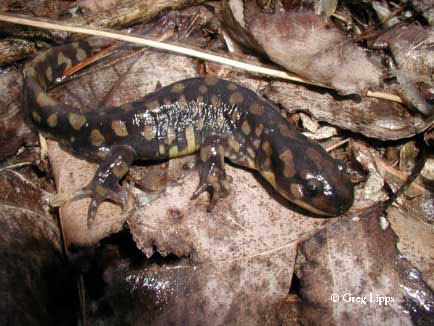
Eastern Tiger Salamander
(Ambystoma tigrinum tigrinum)
 |
 |
|
|
Distribution of the Eastern Tiger Salamander (from the AR MI Atlas)
|
An adult Eastern Tiger Salamander.
|
|
Description: Ohio’s largest terrestrial salamander, measuring up to a foot long. The ground color is a dull black with light yellow to olive spots that are irregular in their shape and distribution. Unlike the Spotted Salamander, the belly is an olive-yellow color. Larvae have a very large head and lack balancers at hatching. |
||
Distribution in Ohio: Spotty distribution throughout the glaciated regions of the state. |
||
|
|
||
Status in Ohio: Uncommon. Records of occurrence are tracked in the state’s Natural Heritage Database. |
||
|
|
||
Habitat: Breed in vernal or permanent pools within or adjacent to forests. Outside of the breeding season, adults remain underground in forests, often living in shrew burrows. |
||
|
|
||
Life history: Migrations to breeding ponds occur in late winter or early spring. Courtship, mating, and egg-laying all occur underwater. Eggs are laid in globular or oblong clusters of 30-50 eggs in water up to 3’ deep. The larvae hatch a couple of weeks later and feed on aquatic invertebrates and other amphibians until metamorphosis in early summer. |
||
|
|
||
Conservation: The Eastern Tiger Salamander relies on wetlands for breeding and adjacent forested habitat for their adult life. Threats to this species include wetland filling and draining, introduction of fish to breeding ponds, pollutants, such as insecticides and herbicides, and loss of adult habitat. |
||
Last modified:
|
Ohio Amphibians · Ohio Salamander Web · Ohio Salamander Species · Amphibian Habitats · Salamander Monitoring |
|